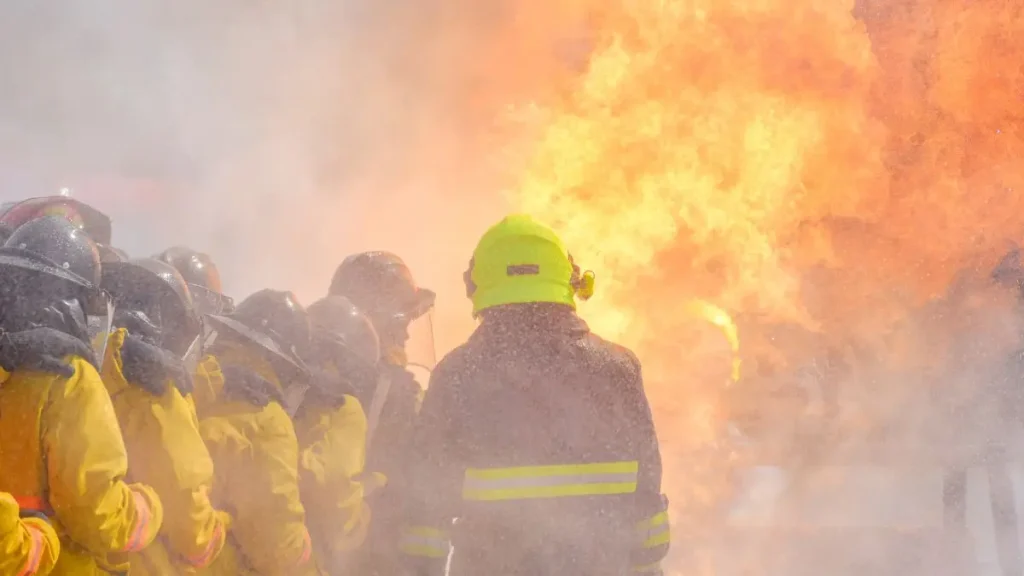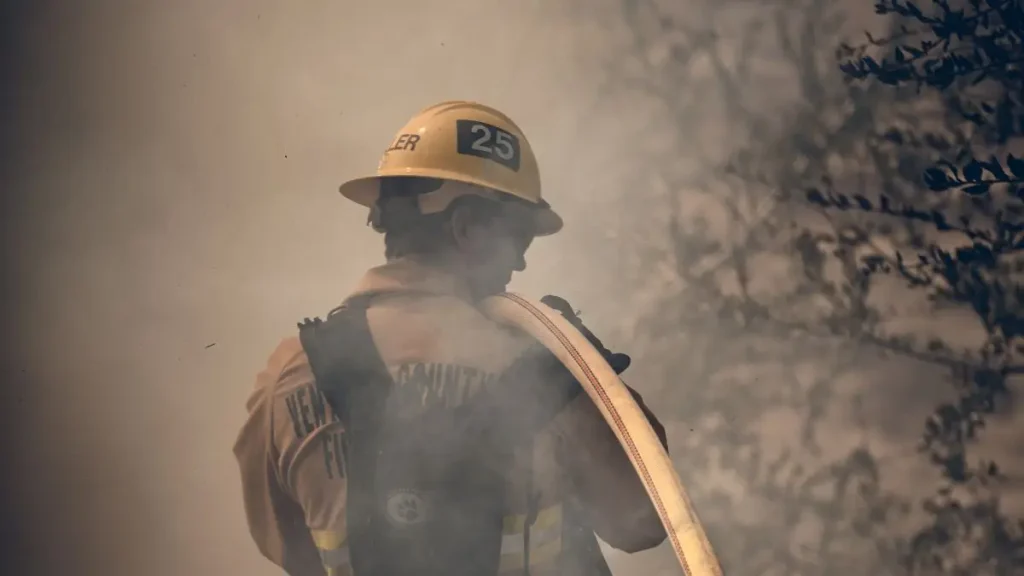New York State Firefighters Battle Major House Blaze
I still remember reading about this fire, and I can’t help but think how quickly a routine day can turn dangerous. Around 12:25 p.m. on Tuesday, firefighters were called to 2969 Brookview Road, just north of Gaylord, after reports of a fire breaking out in the roof. But when the crews arrived, it was clear the situation was far more serious—the flames were engulfing the front of the home.
By the time I tracked updates, the fire had been burning for hours, and firefighters were still battling it well into the afternoon. I found it striking that construction workers were present in the home at the time, yet thankfully, everyone made it out safely. It’s moments like these that remind me just how unpredictable fires can be—and how important it is to have a plan before disaster strikes.
For anyone living nearby, this isn’t just a news story—it’s a real-life caution. The scale of the blaze and the number of departments responding show just how quickly things can escalate, and why staying alert to local emergency updates can make all the difference.
Firefighting Response: Coordinated Efforts

When I first saw the updates from Up North Live, I couldn’t help but feel a mix of awe and concern. Over five fire departments, along with Otsego County Emergency Services, were on the scene, all working together to contain a fire that refused to be tamed. Imagine the logistics: trucks maneuvering through narrow roads, crews communicating over radios, and everyone trying to make split-second decisions while flames spread unpredictably.
Even hours after the initial report, firefighters were still battling the blaze. It really drove home how intense and exhausting fire response can be. This isn’t just a handful of people spraying water—they’re a coordinated force, strategizing constantly to protect lives and property. For someone like you reading this, it’s a reminder that behind every headline about a house fire, there’s a massive human effort working in real time.
The scale of the response also highlights a critical point: fires escalate quickly. A roof fire reported at 12:25 p.m. turned into a full-blown front-of-home blaze by the time crews arrived. The rapid escalation shows how unpredictable fire behavior can be and why immediate, coordinated action matters so much.
Coordinated firefighting efforts aren’t unique to Otsego County; similar large-scale responses have been necessary in events like the North Carolina house fire that required over a dozen firefighters.
Technology in Action: Using Drones
One of the most striking aspects of this fire was the repeated use of drones. Firefighters weren’t just relying on their eyes or instinct—they were getting a bird’s-eye view of the entire property. From my perspective, this is where modern firefighting truly shines. A drone provides instant intel: which areas are burning hottest, which rooms are at risk, and how flames are moving with the wind.
I can’t stress enough how much safer this makes things for the crew. Instead of sending firefighters into unknown danger zones, they can plan attacks strategically. It also gives the public a sense of accountability—residents and nearby neighbors can be reassured that professionals are assessing the scene thoroughly before entering risky areas.
For anyone thinking about safety at home, this is a real takeaway: technology can make a huge difference in emergencies, but only when used correctly. Drones, thermal cameras, and live feed monitoring are the tools that allow firefighters to make precise, life-saving decisions in real time.
Even seemingly contained fires can cause extensive damage overnight, as highlighted in a Delaware home that suffered major destruction after an overnight blaze.
Challenges Faced During the Fire
Fires aren’t just flames—they’re a mix of unpredictability, physics, and sheer endurance. Reading about this Otsego County fire, I noticed several key challenges that made controlling it so difficult. First, the wind played a big role.
Even a strong hose stream struggles when gusts keep pushing flames in new directions. Second, the height of the ceilings in the home added another layer of complexity. Reaching flames high above takes longer, and heat rises, making upper areas extremely dangerous.
These details might seem minor at first glance, but they explain why some fires burn for hours despite a massive crew effort. It’s a sobering reminder that even trained firefighters face serious obstacles, and why public safety protocols—like staying clear of the area—are non-negotiable.
I also reflected on the human side of it. Each decision—where to direct water, when to pull back, how to coordinate with multiple departments—carries weight. Mistakes can be costly, so the pressure on firefighters is immense. As a reader, you can see why it’s not just about putting out flames; it’s about managing risk, timing, and the safety of everyone involved.
Fires can escalate unpredictably, sometimes with tragic results, as seen in other incidents like the Washington State house fire where two people lost their lives.
Community Safety & Public Guidance

One of the most important aspects often missed in news reports is how the community is protected during these events. In this incident, residents were asked to stay away from the area, which isn’t just a suggestion—it’s a lifesaving measure. Construction workers and maintenance personnel were able to evacuate safely, thanks in part to clear protocols and rapid firefighter response.
If I were living nearby, this would make me think about my own readiness. Do I know where to go? How to alert neighbors? What emergency supplies I have on hand? Fires like this aren’t just stories—they’re lessons in situational awareness and preparedness.
I also noticed a broader point: community trust in local fire services matters. When people follow instructions, stay calm, and avoid interference, crews can operate more efficiently. This isn’t just about laws or rules—it’s about saving lives and property through cooperation.
For real-time updates on local fire incidents and safety alerts, you can join communities sharing verified emergency information via WhatsApp.
Lessons from Otsego County Fire
Reflecting on the fire, I see several clear takeaways. First, even when construction or maintenance is happening, fire risks can escalate fast. Being proactive about fire safety isn’t optional—it’s essential. Second, understanding your local fire department’s capabilities, and how to contact them, can save precious minutes in an emergency.
For me, the biggest lesson is how fragile our everyday sense of safety can be. A routine day can turn into a fight against fire, wind, and structural challenges in minutes. But there’s hope: preparedness, awareness, and following expert guidance dramatically improve outcomes.
For you reading this, it’s a reminder to review safety measures at home, ensure everyone knows evacuation plans, and respect local emergency guidance. Fires like these aren’t just statistics—they’re real events with real consequences, and being prepared is the smartest way to protect yourself and your community.
I’d love to hear from you—what fire safety steps have you taken at home? Have you ever experienced a fire emergency? Share your story or tips in the comments below; it could help someone else stay safe.
Final Notes & Safety Takeaways
Looking back at the Otsego County fire, several lessons stand out—lessons that can make a real difference if you or someone you know ever faces a similar situation. First, always have an evacuation plan. Even if construction or maintenance is happening, everyone in the house should know how to get out safely.
Second, stay informed through official channels. Firefighters and local authorities provide real-time updates that are critical for your safety. Ignoring warnings or trying to “see for yourself” can put you in serious danger.
Third, consider fire prevention and readiness at home. Smoke detectors, fire extinguishers, and a clear escape route aren’t optional—they’re essentials. Even small steps, like keeping flammable materials away from work zones or practicing drills, can save lives.
Finally, I want to leave you with this: fires are unpredictable, but preparedness and awareness are in your control. Take the time to review your safety protocols, know your local emergency contacts, and teach everyone in your home what to do in a crisis.
I’d love to hear from you—what fire safety steps have you taken at home? Have you ever experienced a fire emergency? Share your story or tips below; it could help someone else stay safe.
For more stories on home safety and emergency incidents, check out our Home Incidents section for the latest updates and safety tips.
Disclaimer: This article is for informational purposes only and is based on publicly available reports. It does not replace professional advice from fire safety or emergency services. Readers should always follow official guidance during emergencies.


